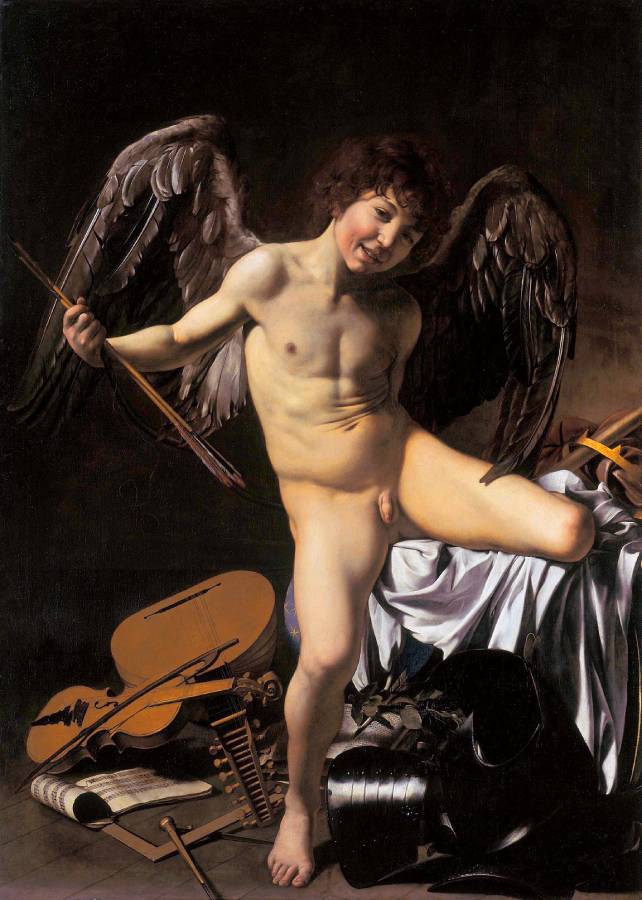Caravaggio (1571-1610)
Amor Vincit Omnia (Love Conquers All / Cupid as Victor)
1601–1602
Oil on canvas, 156.5 x 113.3 cm
Gemäldegalerie, Berlin
Around 1592/93, Caravaggio came to Rome from Lombardy, bringing with him formative impressions of the works of Savoldo, Lotto, Romanino and Moretto. He worked for a time in the workshop of Giuseppe Cesari, one of the leading late Mannerist painters, but soon broke with the conventions of Roman-Florentine Mannerism. His radically new approach – involving a direct recourse to nature, to reality, and the use of focused light and highly contrasting chiaroscuro as pictorial resources – revolutionized art in Rome around 1600, making him one of the pioneering painters of the 17th century alongside Annibale Carracci, Elsheimer, and Rubens. His first important public commission – the paintings for the Contarelli Chapel in San Luigi dei Francesi and the side paintings for the Cerasi Chapel in Santa Maria del Popolo – made him famous. Prominent families acquired or commissioned his works, among them the Mattei, Borghese, and Barberini, and in particular the Giustiniani, who numbered among his most important patrons, and at the same time the most progressive art collectors in Rome: the Marchese Vincenzo Giustiniani (1564–1637) and his brother, Cardinal Benedetto Giustiniani (1544–1637). Of five original works by Caravaggio formerly held in the collection, all of them acquired en bloc by the Prussian king in Paris in 1815, only two survived the immediate consequences of World War II: the Doubting Thomas in the picture gallery in Sanssouci (Potsdam), and the Love Triumphant of 1601–02.
In accordance with Virgil‘s words: “Omnia vincit amor” (Love Conquers All, Eclogae 10.69), the youthful God of earthly love, a smiling victor, triumphs over science, art, power and fame. The instruments and symbols of the “liberal arts”, the laurel of immortal (and primarily literary) fame, and the armor, a symbol of the art and the glory of war, lie scattered at his feet as trophies, the spoils of victory (according to Caravaggio‘s biographer Bellori in 1672): on the left, a music manuscript and two stringed instruments, a violin and a lute, in front of them an angle and compass, the instruments of geometry; behind Amor’s right leg, partially hidden by the laurel branch, an opened, densely written manuscript and reed pen; on the right, near the edge of the picture, behind Amor’s left, bent-back leg, a crown and sceptre as insignia of worldly authority and power. Amor seems to be seated on a blue globe that is decorated with stars, suggesting that he triumphs over the entire world; at the same time, the celestial sphere alludes to the art of astronomy. It seems, however, to have been added by the painter later on. The boy does not really sit on the shallow curve of the globe, but instead on a ledge, from which the drapery falls down on the right-hand side, and on which he has braced his leg. As shown by X-ray images and extensive pentimenti, this edge originally continued leftward beyond the figure of Amor, but was then effaced, overpainted and replaced as a sitting surface by the globe. The playfully precarious, provocative, importunate pose – a travesty of Michelangelo‘s Victory (Florence, Palazzo Vecchio) – and the ambiguous, mocking laughter of the child, who Caravaggio painted from a model chosen from the common people, underscores the most prevalent interpretation of this painting, one audible already in the Giustiniani inventory (1638), and elaborated in particular by Walter Friedlaender in his Caravaggio Studies (1955), according to which Earthly Love delights in deriding the highest moral and intellectual values of humanity, along with our loftiest aspirations. (SMBG)
See also:
• Virgil (70 BC-19 BC): The Georgics (English)
